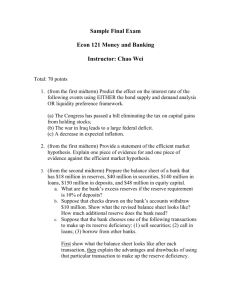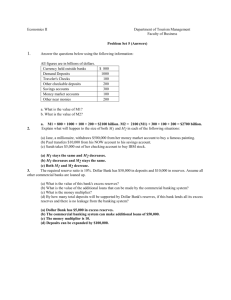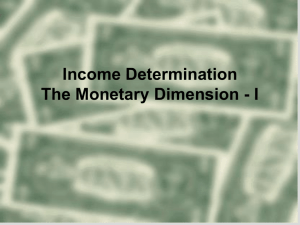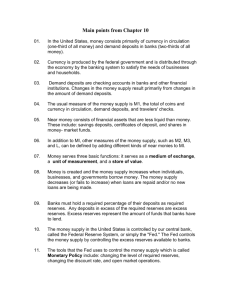Interest Rate
advertisement
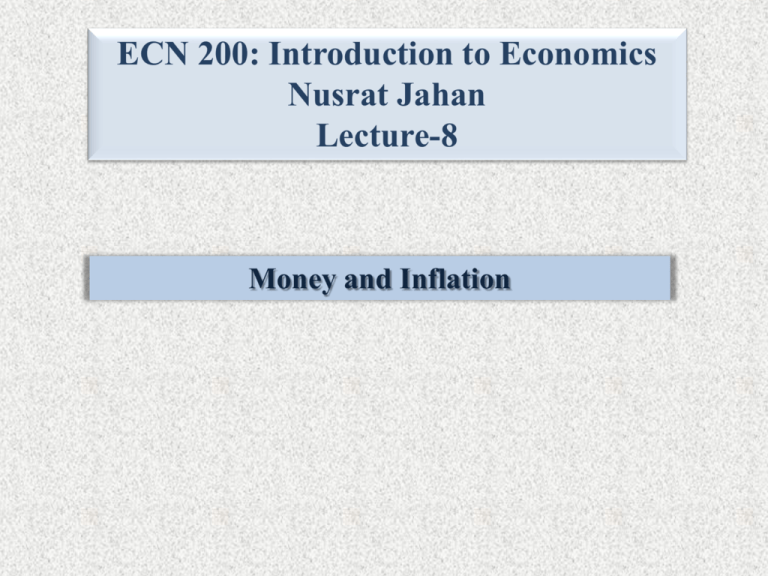
ECN 200: Introduction to Economics Nusrat Jahan Lecture-8 Money and Inflation The meaning of Money Money is the set of assets in an economy that people regularly use to buy goods and services from other people. The functions of Money Medium of exchange A medium of exchange is an item that buyers give to sellers when they want to purchase goods and services. A medium of exchange is anything that is readily acceptable as payment. Unit of account A unit of account is the yardstick people use to post prices and record debts. Store of value A store of value is an item that people can use to transfer purchasing power from the present to the future. The kinds of Money Commodity money – Commodity money takes the form of a commodity with intrinsic value. Examples: Gold, silver, cigarettes. Fiat Money – Fiat money is used as money because of government money decree. It does not have intrinsic value. Examples: Coins, currency, check deposits. Components of Money Supply Transactions Money, M1= Cash + Checking Account Deposits Broad Money, M2= M1 + Small Time Deposits + Money Market Mutual Funds The Price of Money: Interest Rate Interest is the payment made for the use of money. Interest rate is the amount of interest paid per unit of time expressed as a percentage of the amount borrowed. Nominal Interest Rate: It measures the yield in taka per year per taka invested i.e. it is the interest rate on money in terms of money. Real Interest Rate: It measures the quantity of goods we get tomorrow for goods forgone today. Real Interest Rate= Nominal Interest Rate- Inflation Rate Money Creation Banks and the Money Supply Banks can influence the quantity of demand deposits in the economy and the money supply. Reserves are deposits that banks have received but have not loaned out. In a fractional-reserve banking system, banks hold a fraction of the money deposited as reserves and lend out the rest. The reserve ratio is the fraction of deposits that banks hold as reserves. Money Creation with Fractional-reserve Banking When a bank makes a loan from its reserves, the money supply increases The money supply is affected by the amount deposited in banks and the amount that banks loan. Deposits into a bank are recorded as both assets and liabilities. The fraction of total deposits that a bank has to keep as reserves is called the reserve ratio. Loans become an asset to the bank Suppose Ms. Borrower deposits deposits $1000 in her checking account at Bank 1. Assets Liabilities Reserves $1000 Deposits $1000 Total $1000 Total $1000 Table (1): Bank 1’s initial balance sheet If the banks were to keep 100% of the deposit in reserves no extra money would be created. The $1000 checking deposit would just match the $1000 reserve. Suppose reserve ratio is 10%. Bank 1 must set aside as reserve $100 0f $1000 deposit. Assets Liabilities Reserves $100 Loans $900 Total $1000 Deposits $1000 Total $1000 Table (2): Bank 1’s final balance sheet •When one bank loans money, that money is generally deposited into another bank. •This creates more deposits and more reserves to be lent out. •When a bank makes a loan from its reserves, the money supply increases. Bank 1 now has $900 more in reserves than it needs to meet the reserve requirement with which it can make loan. The person who borrows money takes the $900 and deposits it in her account in another bank. The Money Multiplier The money multiplier is the amount of money the banking system generates with each dollar of reserves. The money multiplier is the reciprocal of the reserve ratio: M = 1/R With a reserve requirement, R = 10% or 1/10, The multiplier is 5.



